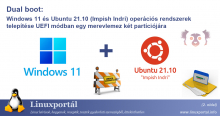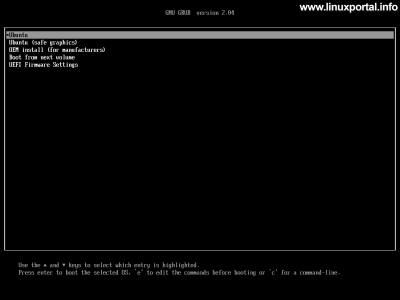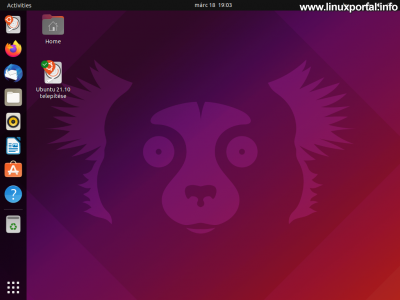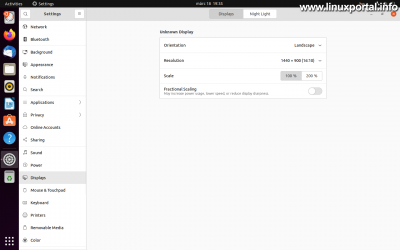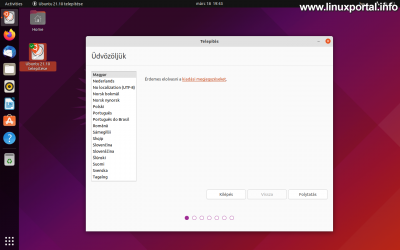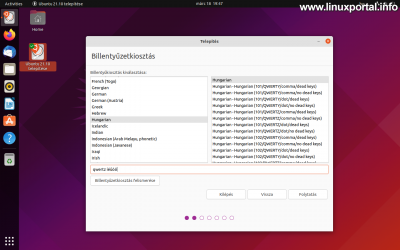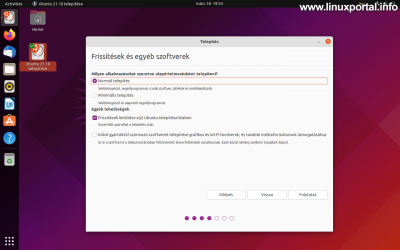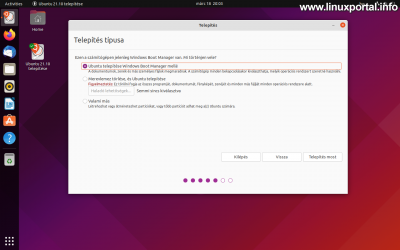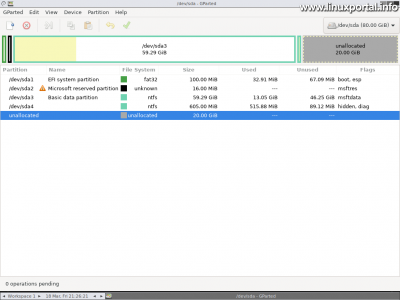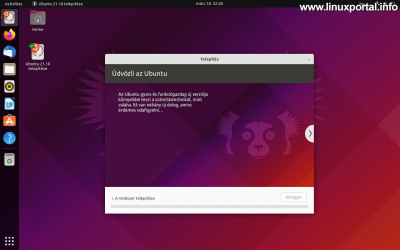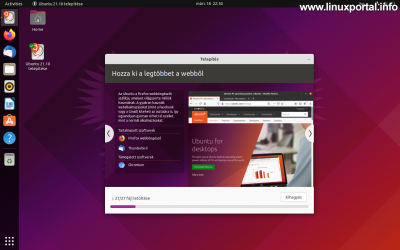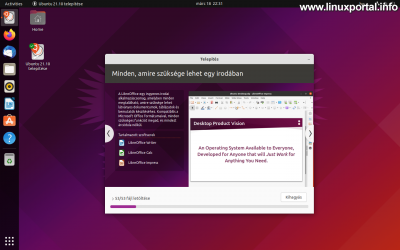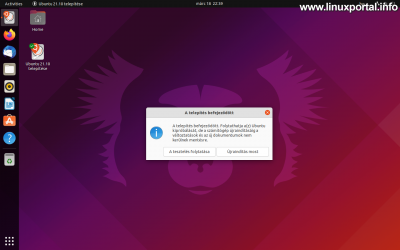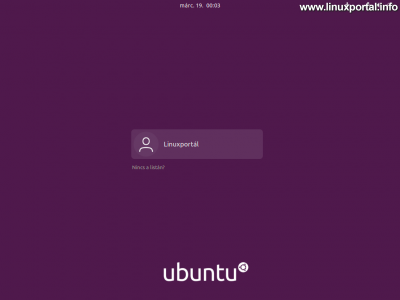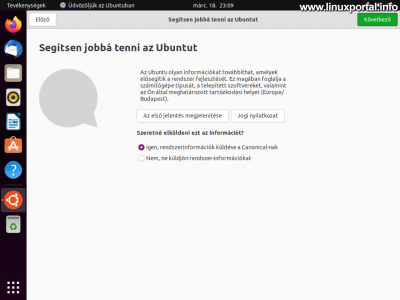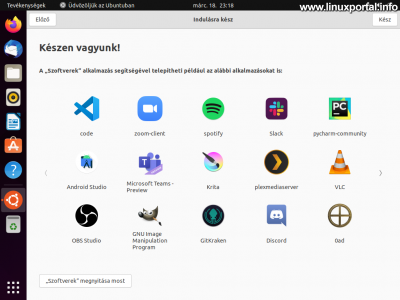Content
- page: Installing Windows 11
- page: Installing Ubuntu 21.10 (Impish Indri)
2. page content
Continuation
The dual-boot description on the first page we have installed the windows 11 operating system UEFI mode one GPT partition schema for the first three partitions, and on this page we will continue to install Ubuntu 21.10 (Impish Indri) Linux as the second system.
Get Ubuntu 21.10 (Impish Indri) and build a bootable device
Ubuntu 21.10 (Impish Indri) was released on October 2021, 14, and is currently (March 2022) the latest Ubuntu release from Canonical Ltd. This release of the operating system will receive software support for 9 months, that is, until July 2022. If this 9 months of support proves to be insufficient for us, it is advisable to opt for Ubuntu 20.04 LTS instead, which will receive updates until April 2030. Source.
It is also interesting to note that the latest LTS release of Ubuntu, April 2022, 21, will also be released on April 22.04, XNUMX. Jammy jellyfish will be codenamed. I will make an installation description of this soon.
Many of the new features in Ubuntu 21.10 (Impish Indri) include support for the newer 5.13 kernel, newer hardware, and the GNOME 40 desktop environment, which is officially part of the system. Of course, it contains many other novelties in addition to these, but we will find out about them in another description.
- Desktop image: With the installation kit, you can try Ubuntu on the fly without changing anything on your machine: a working system will start, running only in memory, and you can look around it. And if you like it, you can start the installer by clicking on the installer icon. This is just like the Live installation kits for Debian systems.
The ISO image file for this installer can be downloaded here (there is also a server version here, but we won't deal with it now, it's just your desktop):
https://releases.ubuntu.com/21.10/ (ISO file size: 2,9GB) - Canary desktop image: This is an experimental installation package that offers another installation method.
The ISO image file for this installer can be downloaded here:
http://cdimage.ubuntu.com/impish/daily-canary/current/ (ISO file size: 3,8GB)
In this installation guide, I will install with the plain Desktop image installer. In another description, we will try the alternative installation method.
After the ISO file has finished downloading, make it a bootable device. Keep in mind that the ISO installation image must be written to your flash drive in UEFI mode. When you are done, start your computer with the installation tool you have created.
Starting the UEFI installer on VirtualBox (optional)
If you are installing on a regular physical computer with a USB flash drive, then skip this section.
And if maybe VirtualBox if we were to prepare this dual boot description, as I am now, then here is one more important thing. I've previously created a troubleshooter to solve a problem with booting ISO installation images in VirtualBox EFI mode:
The phenomenon here is almost the same as in the linked section, with the difference that in this case we do not get an EFI shell now, but our first operating system installed in EFI / UEFI mode, in this case Windows 11, starts automatically. boot order, the inserted ISO image file will be ignored and Windows will start. To do this, I would now like to give you a brief guide on how to start the second operating system installer in EFI / UEFI mode in this case.
So there is a virtual machine that already has an operating system installed. So in this example, Windows 11. Then we want to install Ubuntu 21.10 (Impish Indri) Linux as the second system on the remaining partition of the hard disk, on a separate partition, with the installer's ISO file already set in the DVD drive.
Before booting, migrate the virtual machine to Linux, including Ubuntu (64-bit) on the Basic tab of the General menu.
Then start the virtual machine, and as soon as the virtual machine window opens, the moment you press the ESC key. The Virtualbox EFI menu will appear:
Then use the down arrow key to scroll down Boot Manager menu item, then enter:
Here we select the UEFI VBOX CD-ROM option and start with enter. This is when our ISO installer starts.
Installing Ubuntu 21.10 (Impish Indri)
After starting the installer, first select the standard boot mode GRUB The boot menu welcomes us - which we may have become accustomed to when booting Linux systems.
Boot menu
If we do nothing here for 30 seconds, it will launch the first option. So if you still want to scroll through the menu, use the arrow keys to make your selection and the counter will stop.
Let's briefly review the contents of the menu:
- Ubuntu: This is the default boot method for the installer. With this option, the entire operating system is loaded into memory so we can look around it. This will install you.
- Ubuntu (safe graphics): This is almost the same as the first choice, only here it uses a more general graphics driver for the graphics driver, which works more securely if you might not recognize our graphics hardware properly. So if someone doesn’t see the table with the first option, there’s a good chance it will go away. With a lower resolution, color depth, etc., it can be used to boot the system and later configure the video card properly. So this option is a kind of lifeline to graphic errors.
- OEM installation (for manufacturers): This is a pre-installation method where others can install the system and their personal information is already provided by the end user. I wrote about this option earlier when installing Linux Mint 20.1 (Ulyssa).
- Boot from next volume: This option takes you back to the EFI / UEFI menu in the Boot Manager section, so you can choose another boot device if you did not want to start this installer.
- UEFI Firmware Settings: This returns you to the main page of the EFI / UEFI menu.
Select the first option and the system will be loaded into memory.
Booting Ubuntu live system
Before anyone can stone it, the name Live (capitalized "L") is officially used by Debian for certain types of installation kits. Ubuntu doesn't officially call these installation kits that way, but they do refer to it in many places, so now I've dared to call it that - with a little "l", of course - because it's essentially the same installation method: an almost full-featured operating system is loaded into memory so you can look around it. You can browse, install, play, and more. Of course, the saved documents or any settings or installations will not remain here even after the machine is restarted. This is an excellent way to make sure that the hardware in your computer is fully supported before installation.
So once the system has loaded, we get a window with two options:
Here you can select your language on the left and then try it with the "Try Ubuntu" option in the main part of the panel, or install it immediately with the "Install Ubuntu" option. I'm not starting the installation here yet, I'm going to do a setup before that, so I'll choose the trial option:
Set screen resolution (optional)
This section is not necessary unless the resolution is correct. For example, on my virtual machine, it started with a fairly low resolution, so I set it up so that the whole installation process is more transparent, there are no scrollbars, and there is no way for something to fit in the window. Previously, the With the Debian 10 Calamares Live Installer I had to start the installation again because not all items appeared in some windows during the installation. so if I'm already dealing with a live system, I'll set it up right away if it starts with too low a resolution.
So if you want to set a higher resolution, click on the 3x3 small grid icon in the lower left corner of the desktop:
Here, select the gray "Settings" icon, which is better above me, but it may be elsewhere for a different resolution:
Select "Displays" on the left here:
And here's what's right for you:
In my case, the virtual machine with a window frame with a resolution of 1440x900 appears comfortably, so I set that up.
If you can't find the native screen resolution of your monitor in the list, you have the option to create and configure it from the command line.
When done, confirm the setting at the prompt and exit the settings back to the desktop.
Starting the installer
There is also an installer icon on the desktop labeled "Installing Ubuntu 21.10". Click on it and the installer will start:
If you haven't chosen a language before, you can do so here and continue with the Continue button.
Keyboard Layout
On the second tab, you can set the keyboard layout:
Here we have the opportunity to try the key keys right away. Examples are "qwertz / qwerty" and long accents. Once you've found the allocation that's working properly, move on.
Updates and other software
Here's how to customize this section to suit your own needs:
Since I'm only doing a demo installation right now, I'll move on to the basic settings here.
Installation type
Here the installer detects that you already have a Windows loader on your machine and asks you what to do:
Here you can choose from three options:
- To install Ubuntu with Windows Boot Manager: If you partitioned your hard drive exactly as you did when you installed Windows on the first page, so if you still have enough free space (unpartitioned) on your hard drive, this option will be fine: we won't have to partition it completely automatically. we have nothing to do with it.
- To delete a hard drive and install Ubuntu: This option erases the entire hard drive and performs a fresh Ubuntu installation on the ripped machine. You can also configure LVM and hard disk encryption here.
- Something else: If you select this, the partition manager will come in and you can configure everything yourself. For example, you might want to choose this if you have more than one empty partition on your hard drive, so you want to decide for yourself where Ubuntu should go.
So here, select the first option and then click Install Now. You will be asked for a confirmation and the selected partition will be displayed:
Here we make sure that the system is in the right place. Windows 11 Setup created three visible and one hidden partition, so here I already have 4 partitions based on my own installation. Even after installing Windows, I booted one GParted Liveto see properly what Windows 11 did because it only showed 3 partitions in its installer:
So he even created a 605 MB hidden partition for diagnostics. This makes sense that the Ubuntu installer wants to create partition 5 in the empty space.
I only showed all this so that if we are not sure about our partitions, we can still check that we are not overwriting important data.
So if you've already made sure that the Ubuntu installer's automatic installation "offer" is sure you're installing in the right place, you can move on.
Time zone
In the next step, you can make local settings:
Default is based on the language selected at the beginning, move on if good.
user details
On this page, the user and computer information must be entered:
Fill in as appropriate.
System installation
We have nothing to do here, the installer walks you through loading the system components. In the meantime, you can find out what's new in a scrollable slide show:
After the installer goes through, you will be asked if you want to continue exploring or restart your computer:
Restart the machine.
Restart your system
When you restart your machine, GRUB first loads:
As you can see, both operating systems are already configured in GRUB. Let's take a look at our Windows 11 for the first time, we've seen it a long time ago.
Start Windows 11
For VirtualBox, it is recommended that you switch to the appropriate system before starting the machine.
Select Windows Boot Manager option. Windows 11 will start:
Restarting the machine again ...
Starting Ubuntu 21.10 (Impish Indri)
And if you choose Ubuntu, it will load:
Initial settings
When we first log in, we still have to set up a few things.
Connect to an online account
offers to connect to our online account:
I'll skip this ...
Send system information to Canonical
Privacy Policy
We are ready to!
Then I'll reset my resolution, because unfortunately it didn't ...
Check storage
Finally, I check the storage space to see which operating system is up to date. To do this, I install GParted, which makes it easy to check for unmounted partitions.
To make a reservation for Windows 11 first:
Windows 11 takes up 60 GB of the 13 GB allotted to it.
And Ubuntu 21.10 (Impish Indri) reservation:
And Ubuntu takes up 20GB of the 8,77GB partition.
Interestingly, the two systems combined can now be accessed at about 22GB after a fresh installation.
Conclusion
So this would be a dual-boot combination of Windows 11 and Ubuntu 21.10 (Impish Indri) Linux systems, where we installed the two operating systems on two GPT-based partitions of a hard disk (per head) in UEFI mode, which can then be booted from the GRUB boot menu.
This is a simple, uncomplicated installation that fits perfectly into the second part of the dual-boot / multi-boot description series. Little by little, I keep making several different versions, in the meantime, use it with health!
- Multi-boot systems
- Dual boot: Installing Windows 7 and Debian 10 (Buster) operating systems in BIOS mode on a hard disk
- Ubuntu 22.04 LTS (Jammy Jellyfish) UEFI Mode Installation
- Encyclopedia - UEFI (Unified Extensible Firmware Interface)
- Encyclopedia - GPT (GUID Partition Table)
- Encyclopedia - VirtualBox
- releases.ubuntu.com - 21.10
- cdimage.ubuntu.com - impish - daily-canary - current
- discourse.ubuntu.com - Impish Indri Release Notes
- wiki.ubuntu.com - Releases
- discourse.ubuntu.com - New Desktop Installer Preview Build
- ubuntu.com - Blog - 5 Things to Check Out in Ubuntu Impish Indri
Navigation
- To post registration and login required
- 625 views

